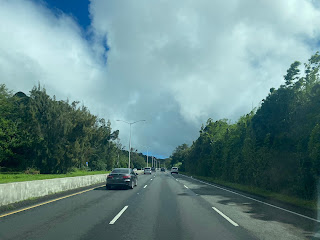Hawaii Route 61 is a 10.8 mile long State Highway mostly known as the Pali Highway. Hawaii Route 61 is one of three highways that crosses the Ko'olau Range of the Island of O'ahu. Hawaii Route 61 originates at Hawaii Route 98/Vineland Boulevard near downtown Honolulu. From Honolulu Hawaii Route 61 ascends through Nu'uanu Valley to the cliffs of Nu'uanu Pali in the Ko'olau Range. From Nu'uanu Pali the alignment of Hawaii Route 61 descends through the Nu'uanu Pali to a northern terminus in Kailua.
This page is part of the Gribblenation O'ahu Highways page. All Gribblenation and Roadwaywiz media related to the highway system of O'ahu can be found at the link below:
https://www.gribblenation.org/p/gribblenation-oahu-highways-page.html
The difficulties of the Pali Trail are stated at the Nu'auanu Pail Lookout via a 1831 quote from Reverend Rueben Tinker:
In 1897 a new alignment of the Pali Road was built directly beneath the 1845 alignment. During excavation of the 1897 Pali Road numerous skull fragments from warriors slain in the 1795 Battle of Nu'aunu were discovered beneath Nu'aunu Pali. The 1897 Pali Road opened to the public during 1898. The 1897 Pali Road featured a 20 foot wide roadway and grades of 8% percent.
During the lead up into World War II the 1897 Pali Road was modernized to facilitate automotive traffic. This culminated in the Pali Road Bridge being completed over the cliffs of Nu'aunu Pail in 1932. The Pali Road Bridge is a concrete stringer design which can be found directly below the Nu'aunu Pali Lookout along with the ruins of the abandoned 1897 Pali Road.
During World War II the territory of Hawaii saw an influx of military activity following the attack on Pearl Harbor on December 7th, 1941. Numerous Military Routes and early Hawaii Routes were signed through the Hawaiian Territory to aid military personnel in navigating the islands. Military Highways were assigned US Route style shields whereas lesser highways were assigned an early variation of what is now the Hawaii Route Spade. A 1946 Army Map of the Island of O'ahu shows the Pali Road assigned as part of Military Route 13 south of Nu'aunu Pali and Hawaii Route 160 north of it. A full version of the 1946 Army Map of O'ahu can be seen on hawaiihighways.com here.
Circa 1955 following the conclusion of World War II the United States Bureau of Public Roads renumbered the Hawaii Route System. The 1955 Hawaii Route renumbering saw most of the conventions utilized by the current Hawaii State Route System established. Primary Hawaii Routes were given two digit numbers whereas Secondary Hawaii Routes were given three digit numbers. The Hawaii Routes were assigned in sequence for what Island/County they were located on coupled with what Federal Aid Program number they were tied to. In the case of O'ahu the Island was assigned numbers in the range of 60-99. A far more detailed explanation of the 1955 Hawaii Route Renumbering can be found at hawaiihighways.com here.
HI 61 east of Interstate H-1 transitions onto the four lane expressway Pali Highway. Approaching Kuakini Street travelers on HI 61 are advised there is access to the National Memorial Cemetery of the Pacific at the Punchbowl Crater.
Punchbowl Crater is an extinct volcanic tuff cone located above downtown Honolulu which is thought to have formed 75,000-100,000 years ago. The National Memorial Cemetery of the Pacific was approved by Congress during February of 1948 and was dedicated on September 2nd, 1949. The National Memorial Cemetery of the Pacific mostly houses the remains of Veterans from World War II, the Korean War and Vietnam War. In total over 61,000 Veterans are interred at the National Memorial Cemetery of the Pacific.
Returning to HI 61 eastbound the highway ascends into Nu'uanu Valley and intersects it's older alignment at Nu'uanu Pali Drive.
Nu'uanu Pali Lookout is located at an elevation of 1,168 feet above sea level. From Nu'uanu Pail Lookout one can see the sheer cliffs for the Ko'olau Mountains contrasted with the waters of Kāneʻohe Bay. Kāneʻohe Bay and the cliffs of the Ko'olau Mountains are the remains of the western half of the Ko'olau Volcano. Much of the Ko'olau Volcano's eastern half has long slid northeast into the Pacific Ocean over a 100 mile wide debris field. Kāneʻohe Bay essentially is the remaining caldera of the Ko'olau Volcano.
Kailua Beach can be found along Kalaheo Avenue at what was likely the original eastern terminus of HI 61. From across Kailua Bay one can see Marine Corps Station Hawaii along with Popoia Island.





















































































Comments